You’re using AI to write stuff. That blogger you follow is using AI. Your favorite thought leader on LinkedIn is using AI too.
It’s 2025, and almost everyone is using AI writing tools as their ghostwriters.
The only problem is that everyone is catching up on AI plagiarism detection tools designed to flag our AI writing.
If you’ve ever had that mini heart attack when someone says, “this doesn’t sound like you wrote it,” you know exactly what I’m talking about.
Whether it’s your professor, your client, or your boss, nobody wants to be called out for passing off AI work as their own.
That’s where AI plagiarism checkers come in.
In this blog, we’re breaking down the 10 best AI plagiarism checker tools of 2025—what they catch, what they cost, and which ones actually help.
What to Look for in an AI Plagiarism Checker
Before we dive into the top tools, let’s talk about what makes a good plagiarism checker.
1. How Accurate Is This? A good AI and plagiarism checker should spot paraphrasing and AI-generated content that feels human.
2. Can It Catch AI Content? – The best AI detectors and plagiarism checker tools can differentiate between human and machine-generated text.
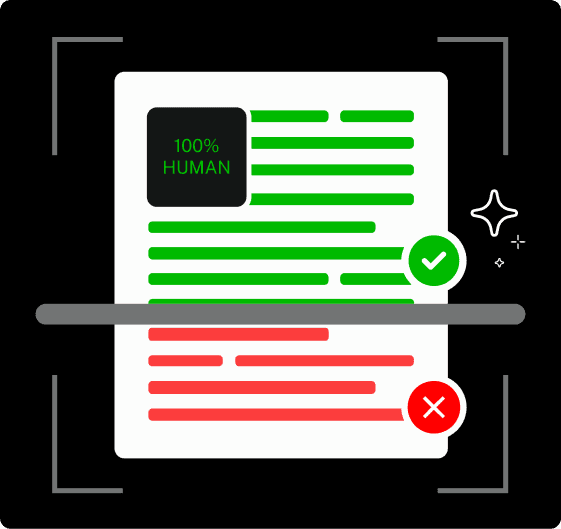
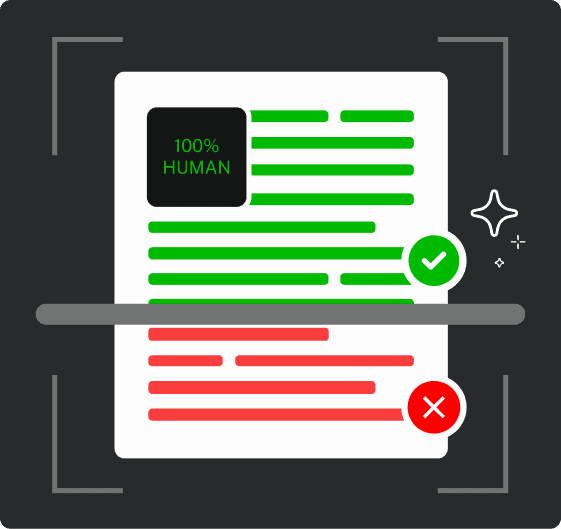
Never Worry About AI Detecting Your Texts Again. Undetectable AI Can Help You:
- Make your AI assisted writing appear human-like.
- Bypass all major AI detection tools with just one click.
- Use AI safely and confidently in school and work.
3. How Strong Is Its Database? – The more sources it checks, the better. A plagiarism and AI checker for students will need to pull from a broader range of resources to ensure comprehensive results.
4. Does It Provide Rewriting Support? – If you’re learning or writing under pressure, that support can be a time-saver.
5. Is It Easy to Use? – Best AI plagiarism checker feels simple—drag, drop, done.
Best AI Plagiarism Checkers in 2025
- 1. Undetectable AI Plagiarism Checker (Recommended)
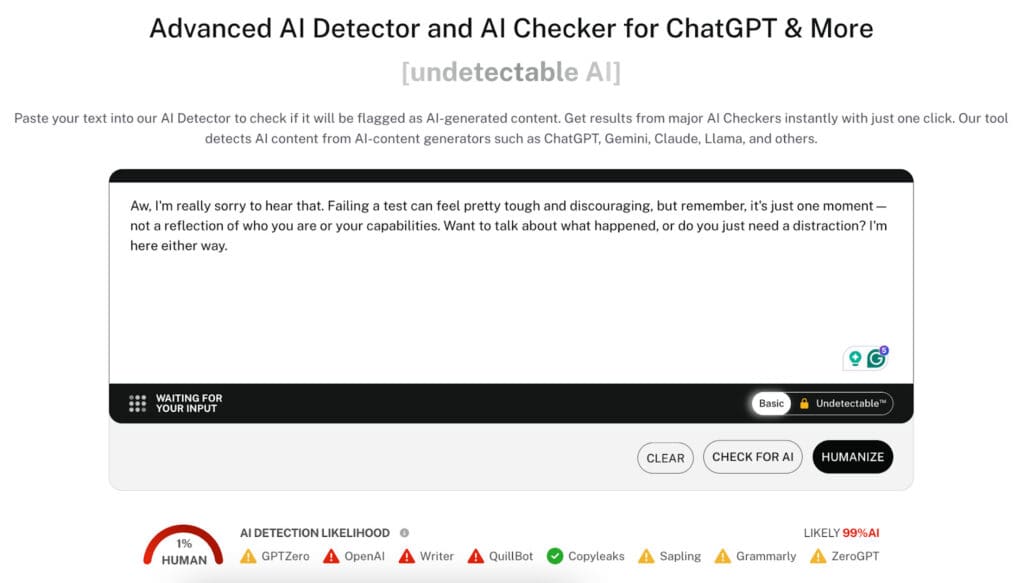
Undetectable AI is an award-winning AI detector featured in Business Insider, ABC, CBS, NBC, Yahoo Finance, Fox, Lifewire, and Nature.
It was rated #1 AI detector by Forbes with over 5,000,000 users as of early 2024.
This AI detector tool is known for its multi-engine AI detection and real-time readability rewrites.
Third parties have reported that it provides 85–95% detection accuracy.
– Pros
- Checks across GPTZero, OpenAI, Writer, QuillBot, Copyleaks, Sapling, Grammarly, and ZeroGPT all at once
- Options like “More Human,” “Balanced,” and “More Readable” for different audiences
- Not just detects but helps rewrite content to bypass AI detection
- Instant access without registration
- Easy to use with real-time feedback
- Shows the likelihood rating from each checker
– Cons
- Requires 200+ words for accurate results
- Not a conventional plagiarism checker (won’t detect copied content)
– Pricing
- $5/month (annual) — Budget-friendly for bloggers, students, researchers.
- $19/month (monthly) — Ideal for short-term or deadline users.
- Custom pricing (business) — Built for agencies, labs, institutions.
We offer a 50% discount on yearly packages. For enterprises with a need for a higher monthly word volume, we offer customized enterprise plans.
Click here to see our pricing in detail.
Additionally, we offer an iron-clad money-back guarantee. If we humanize (conceal) the AI content and it’s still detected, we will refund the cost of humanization completely.
Best fit for: AI-assisted writers, agencies, and researchers avoiding detection.
- 2. Turnitin

Turnitin is the academic gold standard in plagiarism detection, trusted by over 16,000 institutions worldwide.
With powerful AI plagiarism detection, this AI plagiarism detection tool is the go-to tool for ensuring academic integrity and keeping your work original.
– Pros
- Strong against ChatGPT-style outputs.
- Integrated in LMS workflows
- Custom licensing options — Includes iThenticate, Feedback Studio, more.
– Cons
- Occasional false positives.
- Some AI-rewritten content slips through.
- AI detection is not included by default
– Pricing
- Institutional pricing — Varies by institution size and usage.
- AI detection add-ons — Extra cost for full capabilities.
Best fit for: Universities, schools, and academic departments looking for the best AI and plagiarism checker.
- 3. Originality AI
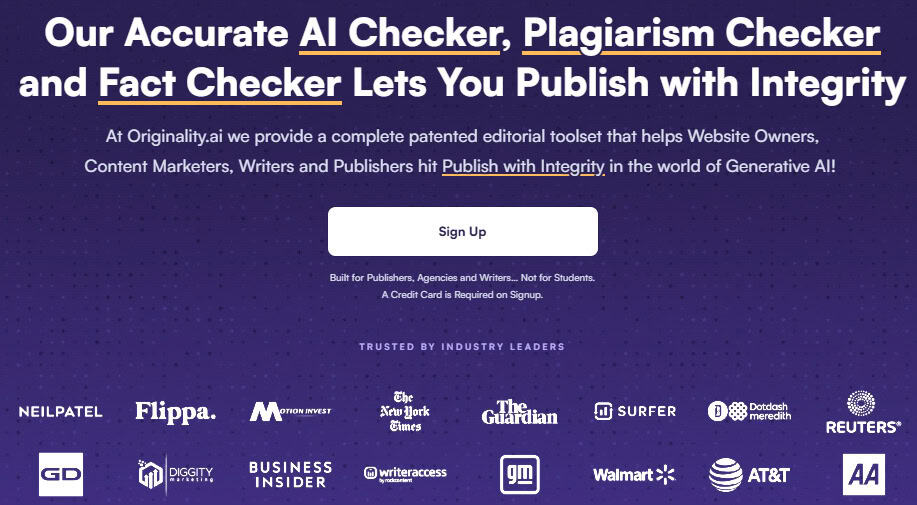
Originality AI is an industry-leading AI plagiarism checker with 99% AI detection accuracy across GPT-4o, Claude 3, Gemini, and Llama.
This AI detector tool is endorsed by WriterAccess, agencies, and major publishers for reliable detection and advanced plagiarism checks.
– Pros
- Proven 99% accuracy for AI content from major LLMs.
- Minimizes false positives — Lite model shows <1% error rate.
- Scans full websites
- Offers API integration
– Cons
- No free tier — Requires a credit card even for trial access.
- Geared toward agencies, not academia.
- May misread poetic or unconventional styles.
- Cloud-only.
– Pricing
- $30 for 3,000 credits (pay-as-you-go)
- $14.95/month for 2,000 credits/month
- Custom plans for enterprises via API
Best Fit For: Agencies, publishers, SEO teams, and platforms needing deep AI and plagiarism detection with team control.
- 4. Grammarly Premium
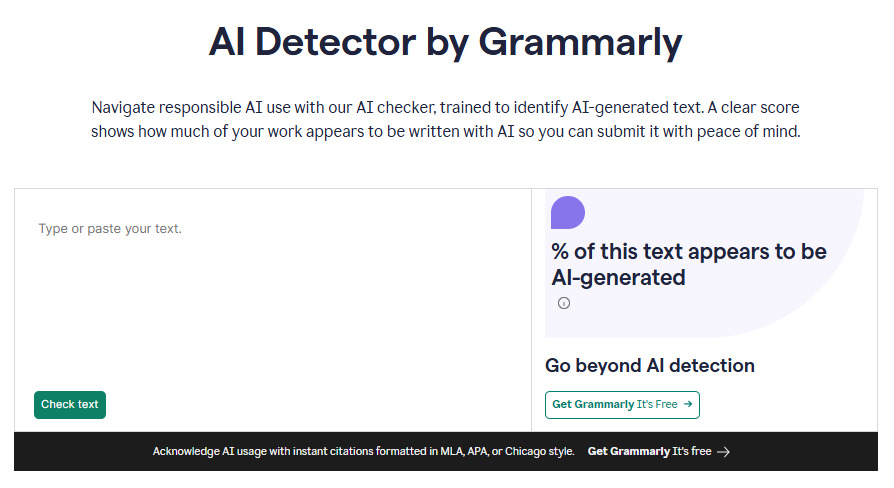
Grammarly is a massively trusted tool with 40M+ users.
It is known for grammar help, but includes basic AI detection and plagiarism support—ideal for students and professionals looking for a best AI and plagiarism checker tool.
– Pros
- Combines AI + grammar tools — Write, detect, cite, and paraphrase in one platform.
- Supports citations (APA/MLA/Chicago), essays, and rewriting.
- Provides real-time help in Docs, browsers, Office, and mobile.
- Free plan available
– Cons
- Less accurate detection on mixed/hybrid or paraphrased content.
- Lacks full-site audits or API access.
- Geared to individuals — Lacks admin tools for teams/agencies.
– Pricing
- $30/month
- $60/quarter
- $144/year
Best Fit For: Students, freelance writers, educators, and anyone wanting a well-rounded writing tool—not for deep AI plagiarism detection audits.
- 5. iThenticate – Good for Researchers

iThenticate is a product by the same company behind ‘Turnitin.’
Unlike other plagiarism and AI-checkers, iThenticate specializes in comparing academic papers against a massive database of over 60 billion web pages and 155 million content items, including leading journals, publications, and research articles.
– Pros
- Trusted by major academic institutions like Elsevier, IEEE, and Springer.
- Purpose-built for academic publishing, government, and medical sectors.
- Offers high-accuracy detection for scholarly plagiarism risks.
– Cons
- Expensive for individuals, with pricing starting at $125/document.
- Not suitable for marketing, casual writing, or student assignments.
- Lacks real-time feedback or app integrations (e.g., Google Docs).
– Pricing
- Single Document: $125 for up to 25,000 words
- Multiple Documents: $300 for up to 75,000 words
- Organization Plan: Custom enterprise pricing
Best fit for: Researchers, academic institutions, and professionals in the publishing, government, and medical fields.
- 6. Copyscape – Good for Blogs

Copyscape is widely used by bloggers and webmasters for a simple reason: it works reliably when it comes to scanning the public web for duplicates.
With Copyscape Premium, you can check documents in bulk, upload Word or PDF files, and use batch search to handle high volumes.
Copysentry, its monitoring service, sends email alerts if your content is copied elsewhere, scanning daily or weekly depending on your plan.
There’s also a side-by-side comparison tool and free plagiarism warning banners to help deter theft before it happens.
– Pros
- Upload PDFs, Word files, and perform bulk searches with Copyscape Premium.
- Enterprise-level solutions for large-scale needs.
- Compare two web pages for plagiarism with a free tool.
- Free plagiarism warning banners to deter theft.
– Cons
- Misses private or gated content behind paywalls.
- Depends on Google’s indexing for plagiarism detection.
- Only detects web-based content, not private documents.
– Pricing
- Premium: $0.03 per search (up to 200 words), $0.01 for each additional 100 words.
- Copysentry Monitoring:
- Basic: $4.95/month
- Professional: $19.95/month
Ideal for: Bloggers, content managers, and businesses.
If you want to make content that works well for SEO, AI SEO Writer can help.
It uses advanced AI to write strong, keyword-rich articles that sound like a real person wrote them.
Whether you’re making list-style articles, how-to guides, or product reviews, AI SEO Writer makes the whole process easier.
Here’s how it helps:
- Drastically reduce content creation time while maintaining quality.
- Eliminate the need for outsourcing or relying on low-quality content.
- Automate extensive keyword research and competitor analysis.
- Ensure articles are humanized to bypass AI detection tools without sacrificing SEO performance.
And the best part? You can try it for free.
Just answer a few quick questions and you’ll get a ready-to-use article that’s both smart and human-like—without all the hard work.
- 7. PlagScan – Good (Student) Alternative to Turnitin
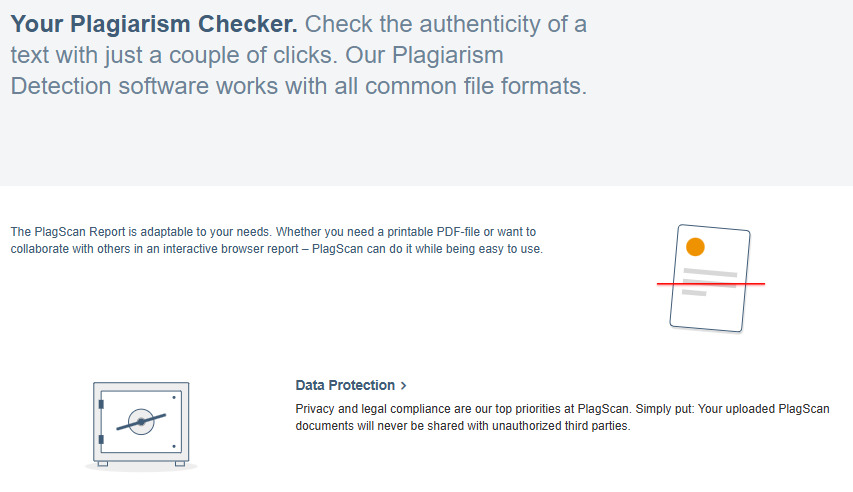
PlagScan is a comprehensive plagiarism detection tool by the same company as Turnitin and iThenticate.
It was created in Germany and follows strict rules to protect your data (called GDPR).
– Pros
- Prioritizes document security with no unauthorized third-party sharing.
- Supports a wide range of file formats, including PDF, DOCX, TXT, and more.
- Intuitive interface ideal for both individuals and academic institutions.
– Cons
- Does not access private academic databases or subscription journals.
- Slower performance when scanning very long or multiple documents.
- Fewer third-party integrations and automation options than competitors.
– Pricing
- Students: ~5.99 for up to 20,000 words
- Business/Institutions: Custom pricing based on volume and use
Best Suited For: Schools and universities seeking the best plagiarism checker AI for students.
- 8. Copyleaks – Good Allrounder
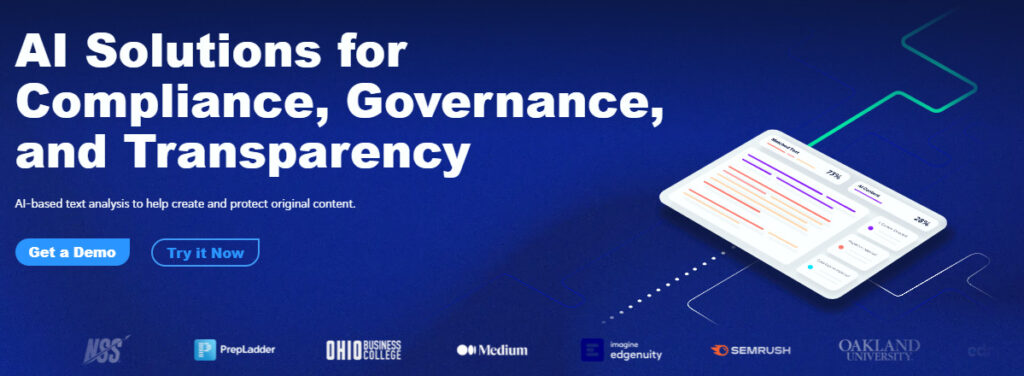
Copyleaks is a smart AI plagiarism checker designed to spot tricky plagiarism.
What makes it stand out is its ability to detect AI-generated content and support for multiple languages.
– Pros
- Detects AI-generated content with over 99% accuracy.
- Supports over 30 languages for global versatility.
- Integrates seamlessly with enterprise APIs and LMS for educational institutions.
– Cons
- Some text input limitations (minimum/maximum word count).
- Risk of false positives in closely mixed AI-human content.
- May flag content edited by tools like Grammarly as AI-generated.
- Over-reliance on AI models may miss highly sophisticated AI-generated content.
– Pricing
- AI Detector: $9.99/month
- Plagiarism Checker: $10.99/month
- AI + Plagiarism Detection: $16.99/month
Ideal for: Content creators, educators, and professionals.
- 9. GPTZero – Good User Interface

GPTZero is a simple, easy-to-use tool that focuses on spotting AI authorship at the sentence level.
What makes GPTZero stand out is its ability to specify parts of the text that might be AI-generated.
Plus, it includes a humanization feature, which helps make AI-written content sound more natural — similar to what tools like Undetectable AI offer.
– Pros
- 99% accuracy in detecting AI-generated content.
- Detects content from major AI models like ChatGPT, Gemini, Llama, and Claude.
- Provides scans, writing feedback, vocabulary checks, and plagiarism detection.
- Works with LMS platforms like Google Classroom, Moodle, and Canvas, plus Chrome extensions.
– Cons
- Premium plans can be costly for casual users or small organizations.
- May not detect newer or lesser-known AI models.
- Primarily designed for educational and business use.
– Pricing
- Essential: $15/month for 150,000 words
- Premium: $24/month for 300,000 words
- Professional: $35/month for 500,000 words
Ideal for: Educators, editors, and content reviewers.
- 10. GLTR – Good for Detecting Older AI-Generated Content
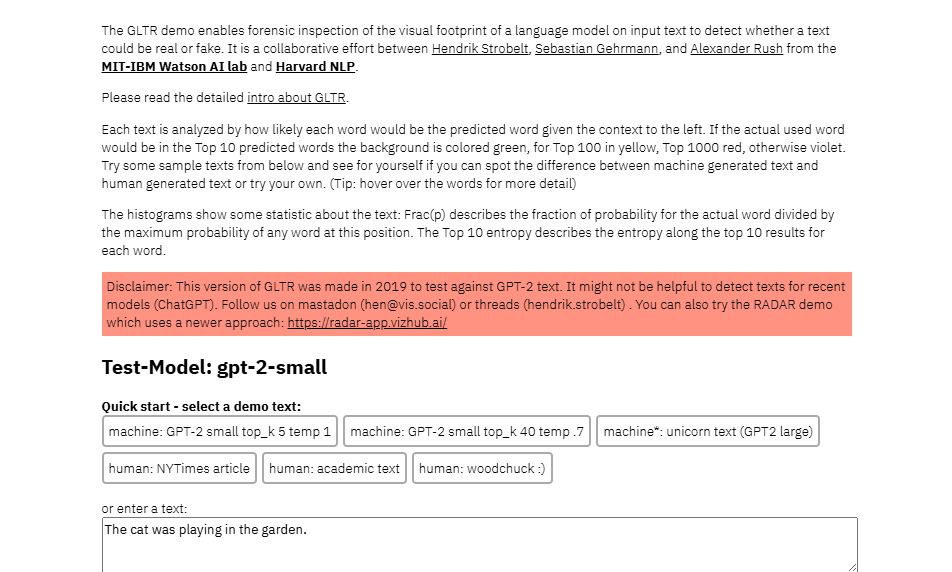
GLTR is a free AI detection tool developed by the MIT-IBM Watson AI Lab and Harvard NLP.
It’s the best free AI plagiarism checker for identifying older AI-generated content.
It was designed to detect older AI-generated content through a unique visual probability mapping system.
– Pros
- Completely free and accessible through a browser.
- Uses color-coded word probability mapping (green/yellow/red/purple) to identify AI likelihood.
- Helps avoid SEO penalties by detecting overly predictable or machine-like text.
– Cons
- Built on GPT-2, limiting effectiveness with newer AI models like GPT-3.5 or GPT-4.
- Does not provide a definitive “AI vs. Human” score; interpretation is subjective.
- Can flag well-structured human writing as AI-generated due to predictability.
- Not suited for large-scale use, as it lacks batch upload and integration features.
– Pricing
- Free to use
Ideal For: Users seeking the best AI and plagiarism checker free for manually reviewing older content in academic or research settings.
How to Use Undetectable AI’s Plagiarism Checker
Getting flagged for AI content can feel frustrating, especially when you’ve spent time making your work sound real. Undetectable AI helps you fix that. Here’s how to use it:
Step 1: Head to the Website
Go to Undetectable AI. You don’t need to sign up.
Step 2: Paste Your Text
There’s a big box that says “PASTE YOUR TEXT HERE.” Copy your content — at least 200 words — and paste it there.
Step 3: Choose How You Want It to Read
You’ll see three choices:
- More Readable – Makes it super simple.
- Balanced – Keeps a nice mix of clear and detailed.
- More Human – This one’s gold if you want to sound less like a robot and more like you.
If your goal is to avoid AI detectors, pick “More Human.” Always.
Step 4: See How ‘AI’ Your Text Sounds
The tool shows you scores from other detectors like GPTZero, OpenAI, Copyleaks, and Grammarly. You’ll see what % of your content each one thinks is AI-written.
Step 5: Click ‘Undetectable™ to Fix It
If your score is high, hit the “Undetectable™” button. It rewrites your text in a way that sounds more natural and human.
Step 6: Copy & Use Your Content
Now that your content is good to go — clear, natural, and safe — copy it and use it wherever you need.
AI Content + Plagiarism: The New Challenge
There was a time when cheating meant copying someone else’s work word for word.
It was easy to catch and easy to stop. Teachers used plagiarism checkers, and the rules were clear.
Now, AI can write full papers, blogs, and even news articles in seconds. Just type a prompt, hit enter, and watch it generate near-perfect content.
At first, it felt like magic. But soon, a tough question follows: “If I didn’t write this… is it still mine?”
That’s the issue today. In a world where AI writes and no one knows what’s real, trust is shaky.
Schools and workplaces are scrambling—some ban AI, others expect it.
There are only gray areas, without solid laws.
Traditional AI plagiarism tools check for copied text.
AI detectors? They look for content that feels too perfect.
But they’re not flawless—real human work sometimes gets flagged, and that creates new problems.
What’s next? We’re only beginning.
Estimates say 1 in 3 online articles could already be AI-written. Still, when used right, AI can help—not harm. It can support struggling writers, spark ideas, and save time.
But when it replaces the human voice, when it removes the struggle, the learning, and the emotion behind words… something important gets lost.
The big question isn’t just, “Is this allowed?” It’s “What kind of world do we want to create with this?”
Pros and Cons of Each Tool
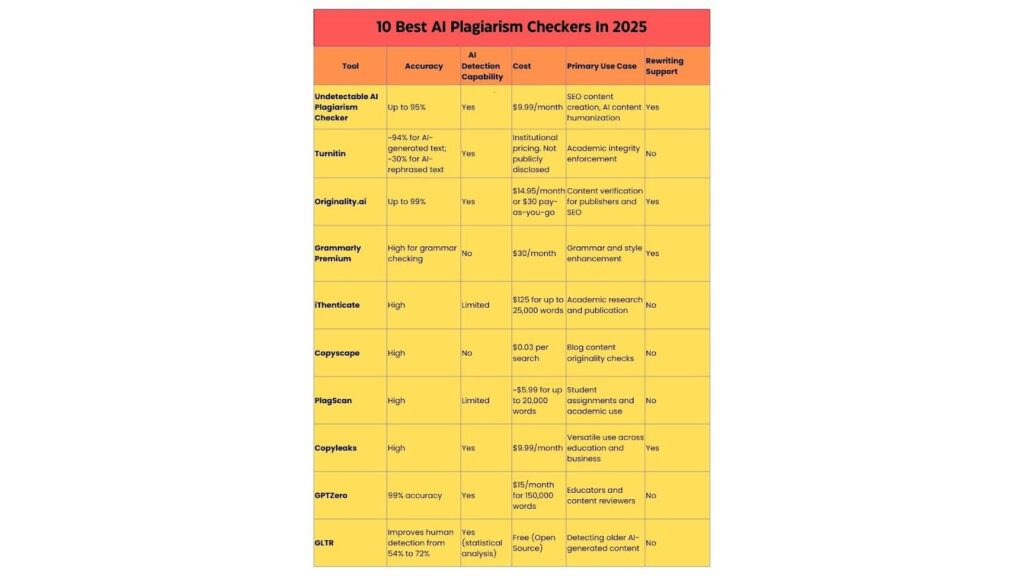
Final Verdict: Best AI Plagiarism Checker
We’ve explored 10 AI plagiarism detection tools, now here’s the thing…
When you use a thesaurus or ask a colleague for feedback, you’re still the author.
But when an AI writes for you based on the prompt, the authorship becomes murky.
- For students: Instead of banning AI, let’s teach critical assessment and transparent citation of AI assistance.
- For professionals: Success might lie in hybrid workflows, where AI handles routine tasks.
- For educators: The opportunity is to redefine “original work” by valuing the process, judgment, and intellectual ownership, not just the output.
The most powerful plagiarism checker isn’t software—it’s your conscience. The best AI detector isn’t an algorithm—it’s your commitment to intellectual honesty.
And the best writing tool isn’t ChatGPT or Claude—it’s your authentic voice, amplified by technology.
So you tell me, what kind of world do you want to help create with your words—AI-assisted or not?
